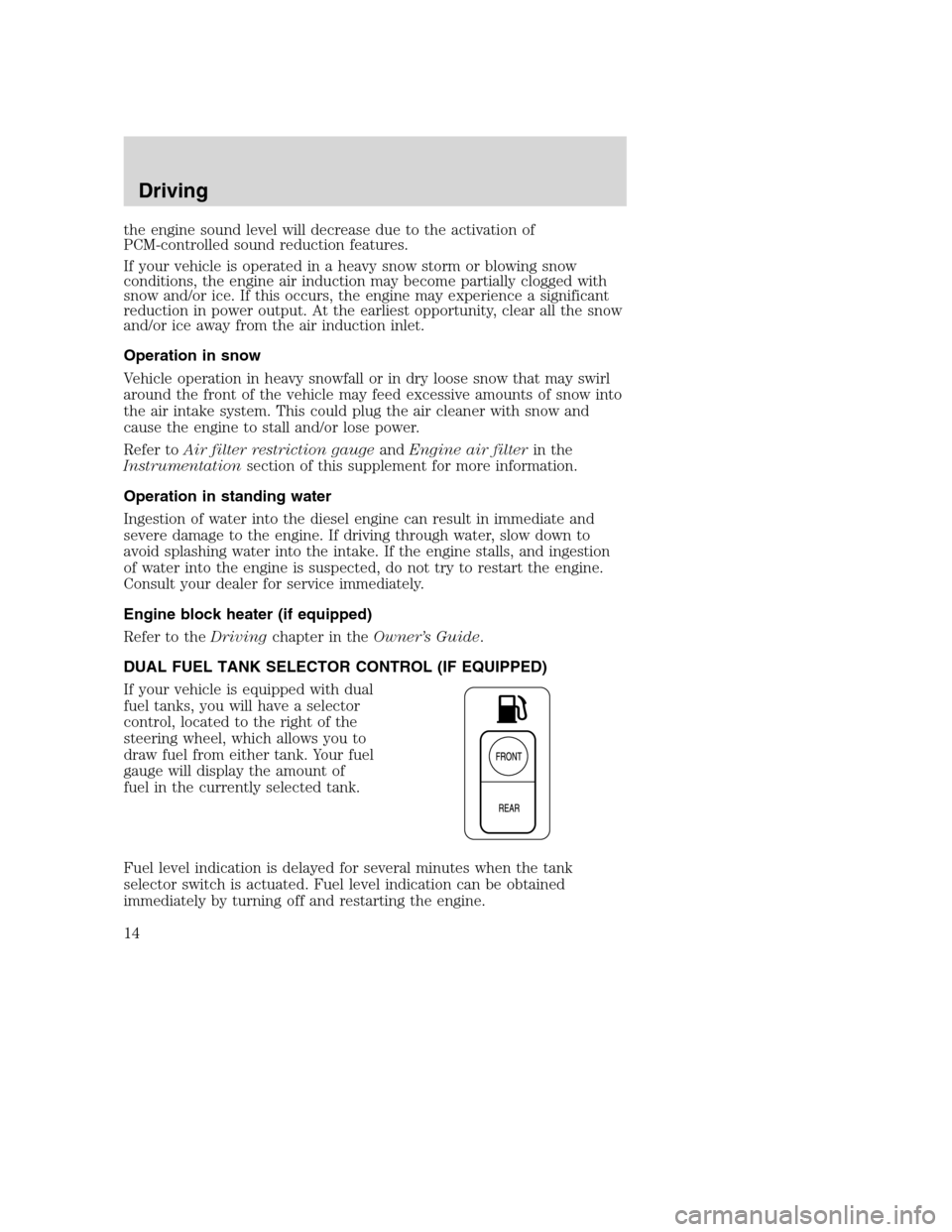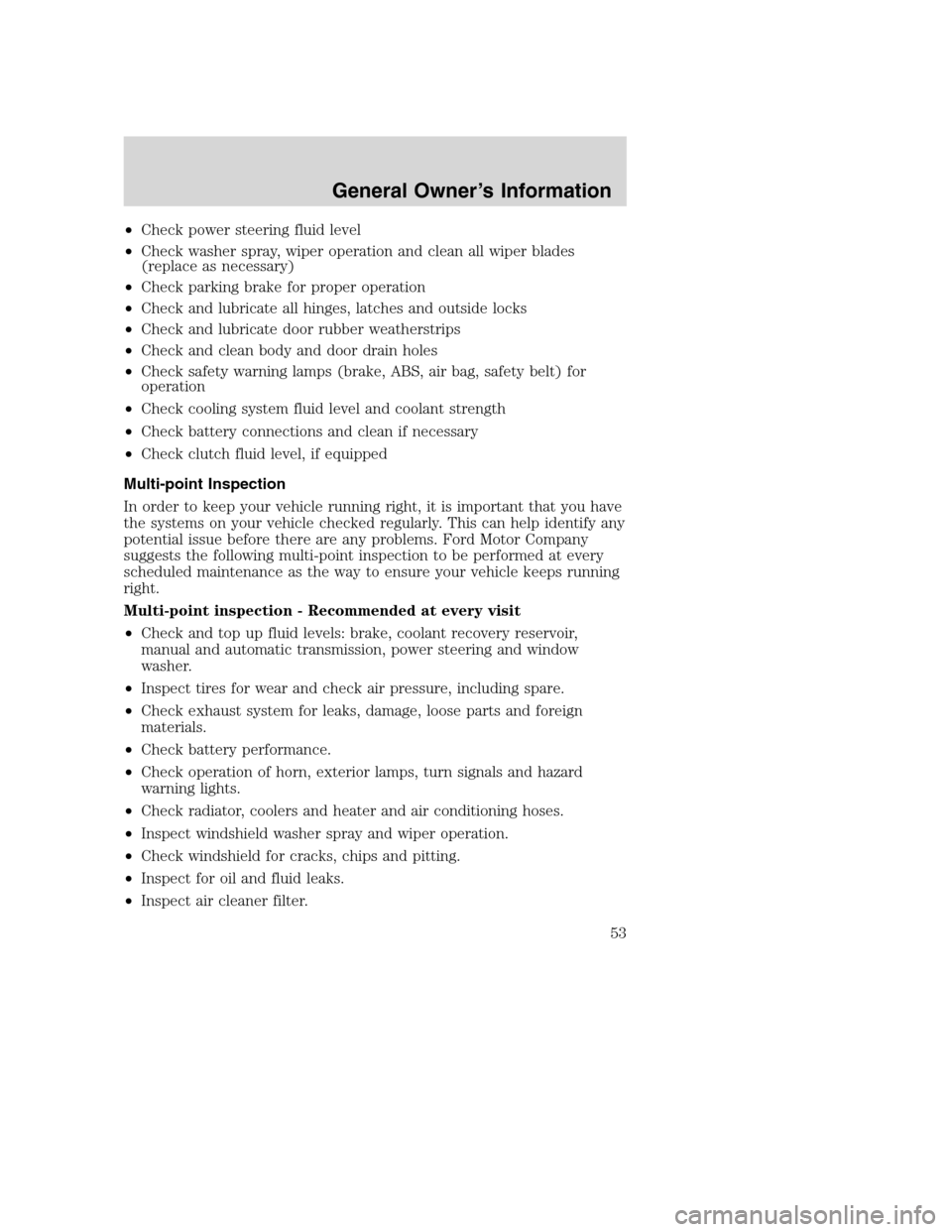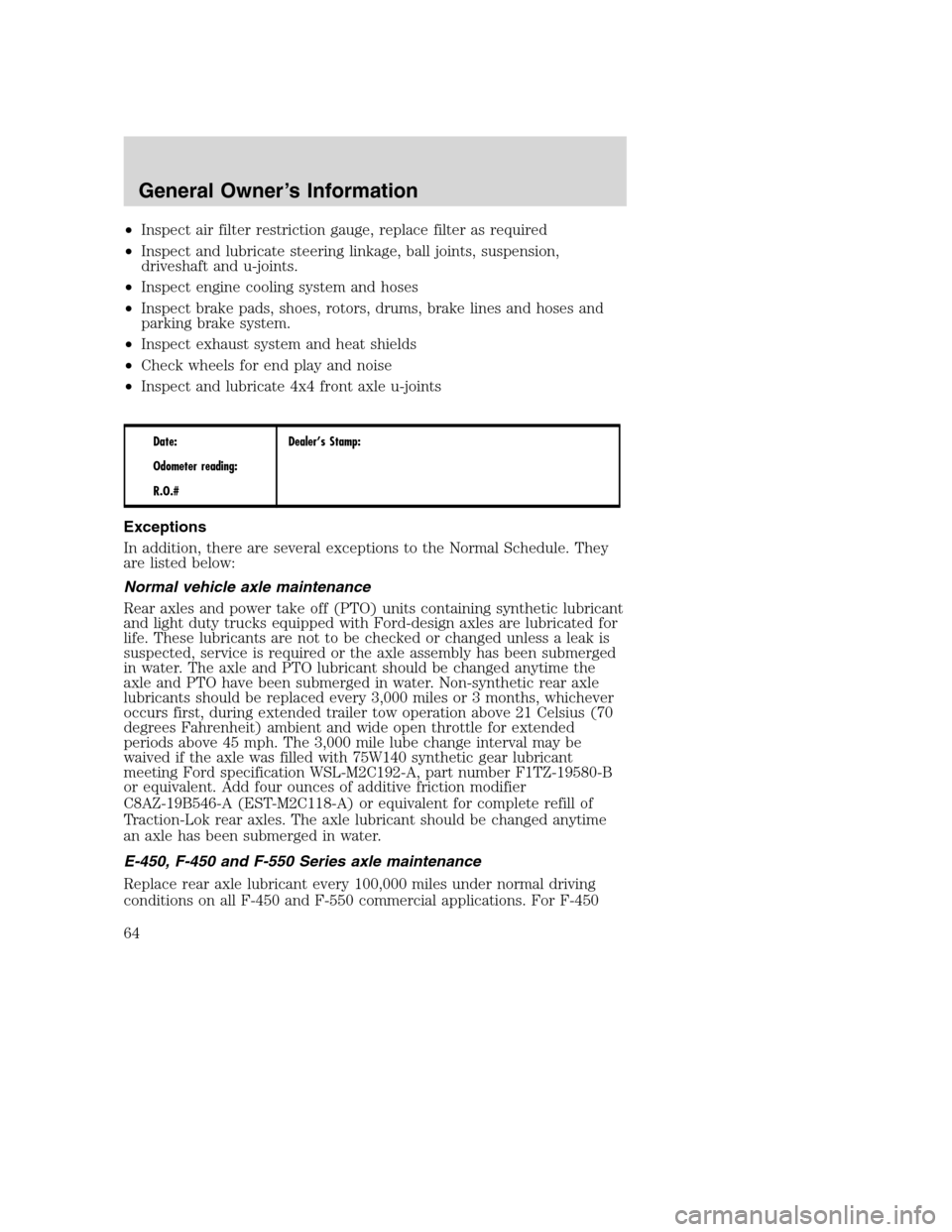Page 14 of 72

the engine sound level will decrease due to the activation of
PCM-controlled sound reduction features.
If your vehicle is operated in a heavy snow storm or blowing snow
conditions, the engine air induction may become partially clogged with
snow and/or ice. If this occurs, the engine may experience a significant
reduction in power output. At the earliest opportunity, clear all the snow
and/or ice away from the air induction inlet.
Operation in snow
Vehicle operation in heavy snowfall or in dry loose snow that may swirl
around the front of the vehicle may feed excessive amounts of snow into
the air intake system. This could plug the air cleaner with snow and
cause the engine to stall and/or lose power.
Refer toAir filter restriction gaugeandEngine air filterin the
Instrumentationsection of this supplement for more information.
Operation in standing water
Ingestion of water into the diesel engine can result in immediate and
severe damage to the engine. If driving through water, slow down to
avoid splashing water into the intake. If the engine stalls, and ingestion
of water into the engine is suspected, do not try to restart the engine.
Consult your dealer for service immediately.
Engine block heater (if equipped)
Refer to theDrivingchapter in theOwner’s Guide.
DUAL FUEL TANK SELECTOR CONTROL (IF EQUIPPED)
If your vehicle is equipped with dual
fuel tanks, you will have a selector
control, located to the right of the
steering wheel, which allows you to
draw fuel from either tank. Your fuel
gauge will display the amount of
fuel in the currently selected tank.
Fuel level indication is delayed for several minutes when the tank
selector switch is actuated. Fuel level indication can be obtained
immediately by turning off and restarting the engine.
Driving
14
Page 27 of 72
IDENTIFYING COMPONENTS IN THE ENGINE COMPARTMENT
E-Series
1. Windshield washer fluid reservoir
2. Automatic transmission dipstick
3. Engine oil filler cap
4. Secondary fuel filter assembly
5. Power steering fluid reservoir
6. Brake fluid reservoir
7. Engine coolant reservoir
8. Air filter assembly
The Fuel Conditioner Module (FCM) is located on the driver-side of the
vehicle next to the transmission case.
Maintenance and Specifications
Maintenance and Specifications
27
Page 28 of 72
F-Super Duty/Excursion
1. Automatic transmission dipstick (if equipped)
2. Engine oil fill
3. Engine oil filter
4. Engine-mounted fuel filter assembly
5. Engine coolant reservoir
6. Brake fluid reservoir
7. Clutch fluid reservoir (if equipped)
8. Underhood relay box
9. Battery (dual batteries shown)
10. Power steering fluid reservoir
11. Air filter assembly
12. Engine oil dipstick
13. Windshield washer fluid reservoir
Maintenance and Specifications
28
Page 53 of 72

•Check power steering fluid level
•Check washer spray, wiper operation and clean all wiper blades
(replace as necessary)
•Check parking brake for proper operation
•Check and lubricate all hinges, latches and outside locks
•Check and lubricate door rubber weatherstrips
•Check and clean body and door drain holes
•Check safety warning lamps (brake, ABS, air bag, safety belt) for
operation
•Check cooling system fluid level and coolant strength
•Check battery connections and clean if necessary
•Check clutch fluid level, if equipped
Multi-point Inspection
In order to keep your vehicle running right, it is important that you have
the systems on your vehicle checked regularly. This can help identify any
potential issue before there are any problems. Ford Motor Company
suggests the following multi-point inspection to be performed at every
scheduled maintenance as the way to ensure your vehicle keeps running
right.
Multi-point inspection - Recommended at every visit
•Check and top up fluid levels: brake, coolant recovery reservoir,
manual and automatic transmission, power steering and window
washer.
•Inspect tires for wear and check air pressure, including spare.
•Check exhaust system for leaks, damage, loose parts and foreign
materials.
•Check battery performance.
•Check operation of horn, exterior lamps, turn signals and hazard
warning lights.
•Check radiator, coolers and heater and air conditioning hoses.
•Inspect windshield washer spray and wiper operation.
•Check windshield for cracks, chips and pitting.
•Inspect for oil and fluid leaks.
•Inspect air cleaner filter.
General Owner’s Information
53
Page 64 of 72

•Inspect air filter restriction gauge, replace filter as required
•Inspect and lubricate steering linkage, ball joints, suspension,
driveshaft and u-joints.
•Inspect engine cooling system and hoses
•Inspect brake pads, shoes, rotors, drums, brake lines and hoses and
parking brake system.
•Inspect exhaust system and heat shields
•Check wheels for end play and noise
•Inspect and lubricate 4x4 front axle u-joints
Date:
Odometer reading:
R.O.#Dealer’s Stamp:
Exceptions
In addition, there are several exceptions to the Normal Schedule. They
are listed below:
Normal vehicle axle maintenance
Rear axles and power take off (PTO) units containing synthetic lubricant
and light duty trucks equipped with Ford-design axles are lubricated for
life. These lubricants are not to be checked or changed unless a leak is
suspected, service is required or the axle assembly has been submerged
in water. The axle and PTO lubricant should be changed anytime the
axle and PTO have been submerged in water. Non-synthetic rear axle
lubricants should be replaced every 3,000 miles or 3 months, whichever
occurs first, during extended trailer tow operation above 21 Celsius (70
degrees Fahrenheit) ambient and wide open throttle for extended
periods above 45 mph. The 3,000 mile lube change interval may be
waived if the axle was filled with 75W140 synthetic gear lubricant
meeting Ford specification WSL-M2C192-A, part number F1TZ-19580-B
or equivalent. Add four ounces of additive friction modifier
C8AZ-19B546-A (EST-M2C118-A) or equivalent for complete refill of
Traction-Lok rear axles. The axle lubricant should be changed anytime
an axle has been submerged in water.
E-450, F-450 and F-550 Series axle maintenance
Replace rear axle lubricant every 100,000 miles under normal driving
conditions on all F-450 and F-550 commercial applications. For F-450
General Owner’s Information
64